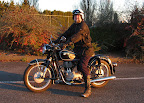I like THAT thought!mattcfish wrote:If that was possible you could get twice the miles out of those expensive sprockets. Run a single chain on one row until it's warn down....then put a chain on the other row the next time.
Condition Monitoring the Timing Chain
Re: Running a single chain on dual sprockets ...
Some of the above is fact, some is fiction, some is my personal imagination and some is just simple truth. [me]
http://www.stephenbottcher.net
http://www.stephenbottcher.net
Re: Condition Monitoring the Timing Chain
I just replaced the chain and crank sprocket on my '81RS (55K). The timing mark was very wiggly.
Wrench told me it probably wouldn't change the mark.
He was wrong.
The timing mark is now very easy to see!
Wrench told me it probably wouldn't change the mark.
He was wrong.
The timing mark is now very easy to see!
Re: Running a single chain on dual sprockets ...
My unproven and half baked theory as to why the sinlge row chain lasts longer is:StephenB wrote:I like THAT thought!mattcfish wrote:If that was possible you could get twice the miles out of those expensive sprockets. Run a single chain on one row until it's warn down....then put a chain on the other row the next time.
The double row sprockets must be made to a much closer tolerance and mounted absolutly in line with one another so that the load on both rows of the chain is identical. If there is a tiny bit more load on one side of the chain it will begin to wear quicker, wearing the sprockets unevanly makeing things worse. As well the mass of the cam sprocket is half on a single row set up. As soon as there is a tiny bit of play in the chain, the snatching back and forth is less strain with the lighter weight single row. For that reason, I don't see a single row chain lasting as long on a double sprocket as it would on the single.
That being said, it is so easy to change just the chain, you could get a much longer sprocket life useing a singlechain on a new double sprocket. But the single sprockets are much cheaper.
As stated above, just theory, as sound as cold fusion.
Garnet


Re: Running a single chain on dual sprockets ...
The only sprocket you would have a play issue with would be the lower cam sprocket. It can be lightened substantially by drilling more or larger holes, just like the old flywheels. The single chain has less mass, so play from it is going to be less of an issue.Garnet wrote:My unproven and half baked theory as to why the sinlge row chain lasts longer is:StephenB wrote:I like THAT thought!mattcfish wrote:If that was possible you could get twice the miles out of those expensive sprockets. Run a single chain on one row until it's warn down....then put a chain on the other row the next time.
The double row sprockets must be made to a much closer tolerance and mounted absolutly in line with one another so that the load on both rows of the chain is identical. If there is a tiny bit more load on one side of the chain it will begin to wear quicker, wearing the sprockets unevanly makeing things worse. As well the mass of the cam sprocket is half on a single row set up. As soon as there is a tiny bit of play in the chain, the snatching back and forth is less strain with the lighter weight single row. For that reason, I don't see a single row chain lasting as long on a double sprocket as it would on the single.
That being said, it is so easy to change just the chain, you could get a much longer sprocket life useing a singlechain on a new double sprocket. But the single sprockets are much cheaper.
As stated above, just theory, as sound as cold fusion.
Bellingham, WA USA
1975 BMW R90/6
1975 BMW 2002
1971 VW Westfalia
1985 VW Vanagon
http://advrider.com/index.php?threads/b ... s.1074183/
1975 BMW R90/6
1975 BMW 2002
1971 VW Westfalia
1985 VW Vanagon
http://advrider.com/index.php?threads/b ... s.1074183/
Re: Condition Monitoring the Timing Chain
I'm still trying to understand why a double row chain would wear quicker than a single row - in power transmission terms it should be at least 50% stronger, no?
"Never argue with a fool, onlookers might not be able to tell the difference." Samuel Clemens
Re: Condition Monitoring the Timing Chain
Do the joining pins go through both chains?DanielMc wrote:I'm still trying to understand why a double row chain would wear quicker than a single row - in power transmission terms it should be at least 50% stronger, no?
A longer pin would be more susceptible to any misalignment, no matter how slight.
Just a thought.
Lord of the Bings
Re: Condition Monitoring the Timing Chain
It is a dual-row chain, one piece, with the masterlink going through both "halves" ... but ... there are no halves, it is a dual-row chain.
Some of the above is fact, some is fiction, some is my personal imagination and some is just simple truth. [me]
http://www.stephenbottcher.net
http://www.stephenbottcher.net